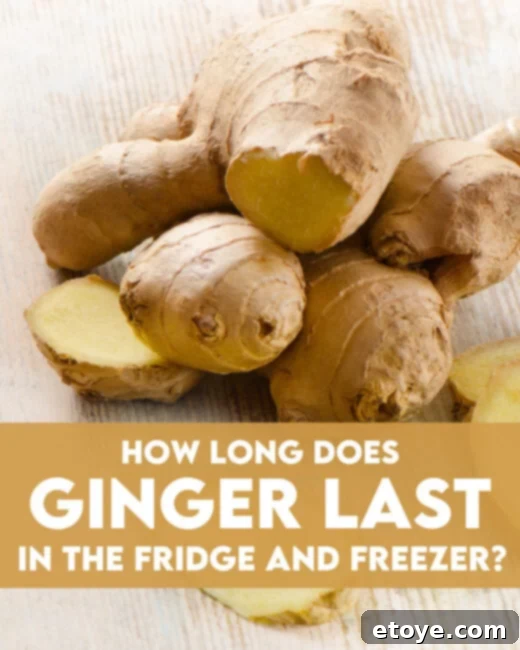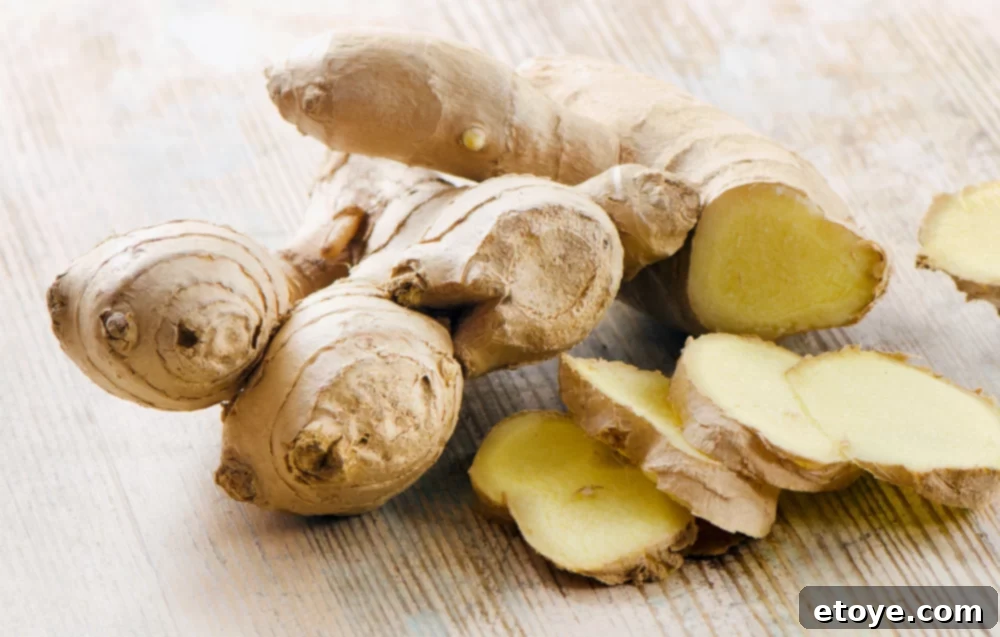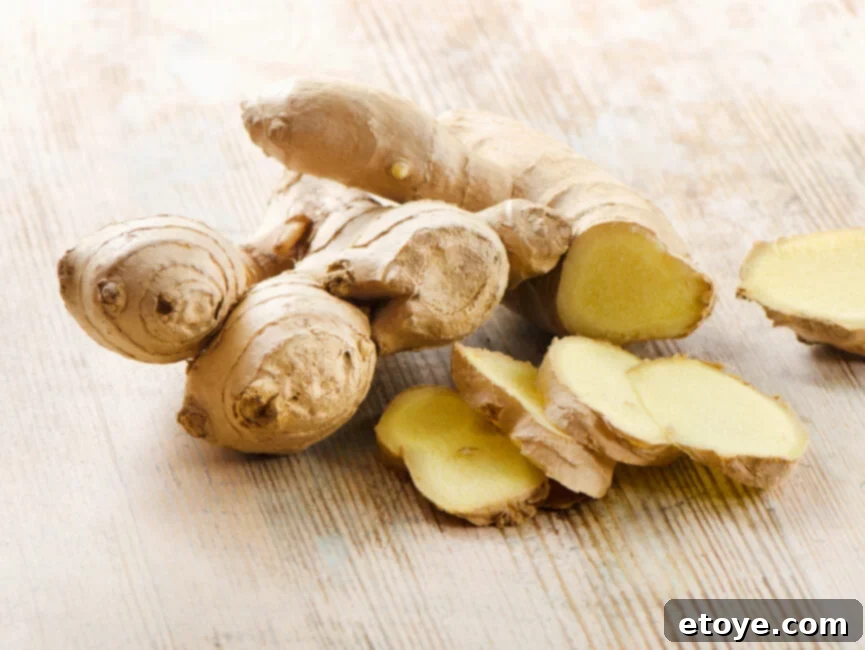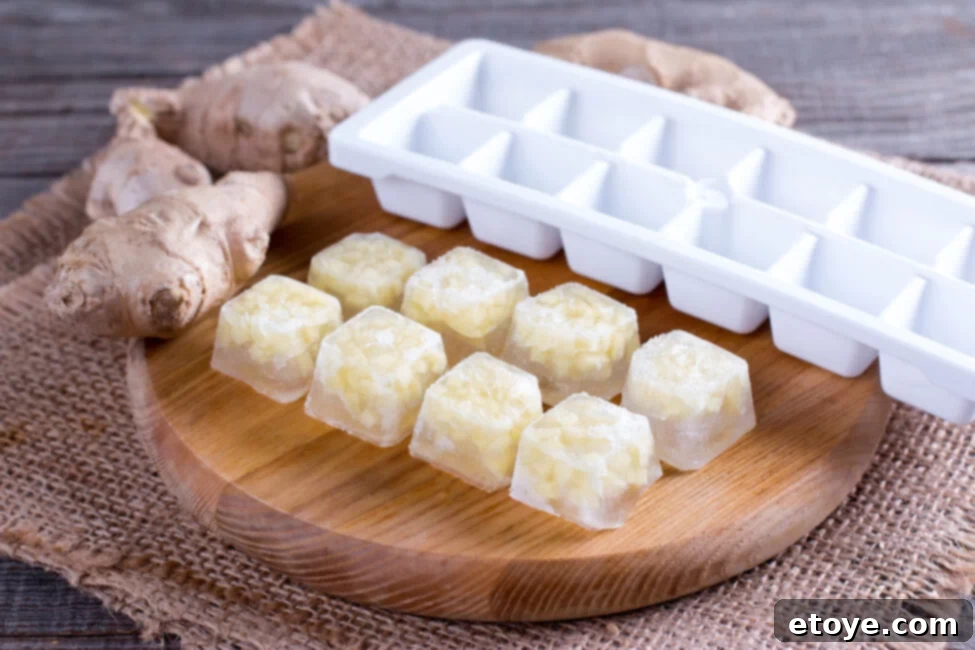Ginger, with its distinctive spicy kick, warm aroma, and impressive health benefits, is a truly multifaceted ingredient. It effortlessly enhances everything from vibrant curries and savory stir-fries to refreshing salad dressings and soothing teas. Beyond its culinary versatility, fresh ginger root is a powerhouse of wellness, celebrated for its potent anti-inflammatory and digestive properties. However, despite its many virtues, this valuable root often finds itself forgotten.
It’s a common kitchen scenario: you buy a beautiful, plump knob of ginger with the best intentions, only for it to be discovered weeks later, shriveled and forlorn, at the bottom of your crisper drawer. You’re certainly not alone in this predicament! This frequent oversight leads to a crucial question that many home cooks ponder: How long does ginger last in the fridge? And more importantly, what can we do to preserve its peak freshness, ensuring it’s always ready to infuse our dishes with its signature zing?
The Quick Answer: Unlocking Ginger’s Shelf Life in Your Fridge
For those seeking a swift answer, here’s the essential information: Whole, unpeeled fresh ginger root can comfortably stay fresh and potent in your refrigerator for approximately three weeks to a month. This impressive longevity, however, isn’t a guarantee. The actual duration your ginger remains at its best is influenced by several critical factors, including whether the ginger is whole or cut, peeled or unpeeled, and most significantly, the specific method used for its storage. Join us as we peel back the layers (pun intended!) to reveal the best strategies for keeping your ginger vibrant and full of its invigorating spice for as long as possible.
Key Factors That Dictate the Shelf Life of Fresh Ginger
Understanding the variables that impact how long ginger stays fresh is the first step toward effective preservation. Keeping ginger in its prime requires a delicate balance; excessive moisture can lead to mold and rot, while too little will cause it to dry out, shrivel, and lose its aromatic potency. Here are the primary factors influencing the fridge life of your ginger:
- Whole vs. Cut or Peeled Ginger: This is arguably the most critical determinant. Whole, unpeeled ginger roots are naturally protected by their robust skin, which acts as a barrier against air exposure, moisture loss, and microbial contamination. Once this protective layer is breached by cutting or peeling, the ginger’s flesh becomes vulnerable. Exposure to air accelerates oxidation and evaporation, significantly reducing its shelf life. Therefore, whole ginger always outlasts its cut or peeled counterparts.
- Storage Environment: Temperature and Humidity: The ambient conditions where ginger is stored play an enormous role. While ginger can survive on a kitchen counter at room temperature for a short period (typically up to a week), the cool, consistent environment of a refrigerator drastically slows down the enzymatic processes that lead to spoilage. Specifically, the crisper drawer in your fridge is engineered to maintain optimal humidity levels, making it the ideal sanctuary for fresh produce like ginger, preventing both excessive drying and unwanted moisture accumulation.
- Quality at Purchase: The journey of your ginger’s freshness begins even before it enters your home. Always prioritize selecting firm, plump ginger roots with smooth, taut skin. Avoid any pieces that feel soft, appear wrinkly, or show visible signs of mold, bruising, or sprouting. Starting with high-quality ginger provides a much longer window of freshness for storage.
- Exposure to Air and Light: Air, particularly oxygen, is ginger’s adversary in long-term storage. Oxygen exposure accelerates the oxidation process, which degrades the volatile compounds responsible for ginger’s distinctive flavor, aroma, and even its nutritional benefits. Direct light can also hasten deterioration. This is why airtight and dark storage methods are consistently recommended to maximize freshness and preserve potency.
- Sell-by / Use-by Dates: Unlike many pre-packaged food items, fresh ginger root rarely comes with explicit sell-by or use-by dates. This means you’ll need to rely primarily on your own senses and judgment to determine its freshness.
Recognizing the Signs That Ginger Has Gone Bad: Your Sensory Inspection Guide
Determining if your ginger has passed its prime doesn’t require complex scientific analysis; your senses are your most reliable tools. A quick check of its appearance, texture, and aroma will provide all the clues you need to ensure you’re using only the freshest ingredient.
- Trust Your Sniffer: Fresh ginger emanates a strong, zesty, peppery, and subtly sweet aroma that is unmistakable. If, upon smelling your ginger, you detect an off-putting sour, musty, moldy, or even an absence of its characteristic fragrance, these are definitive indicators that it’s beginning to spoil. A lack of aroma often signals a loss of its essential volatile compounds, leading to significantly diminished flavor and potency.
- Trust Your Touch: A healthy, fresh knob of ginger should feel firm, solid, and dense to the touch, with a smooth, firm skin. When ginger starts to degrade, its texture changes dramatically. It may become soft, mushy, or rubbery, and you might easily be able to indent it with your finger. This softness is primarily due to internal moisture loss or the breakdown of its cellular structure. If it feels spongy, it’s time to say goodbye.
- Trust Your Peepers: Visual cues are often the most obvious indicators of spoilage. Inspect the ginger closely for any visible signs of mold, which can manifest as fuzzy, discolored patches (green, blue, black, or white) on the skin or even within the flesh if you cut into it. Discoloration, such as dark spots, a grayish hue, or a significant departure from its natural golden-brown color, also signals deterioration. While green sprouts indicate the ginger is trying to grow, it doesn’t necessarily mean it’s spoiled, though it might suggest a slight reduction in flavor.
While consuming slightly spoiled ginger is generally not as dangerous as ingesting other types of spoiled food (it’s less likely to cause severe food poisoning), it can certainly lead to an unpleasant bitter taste and potential digestive distress. If you find yourself eyeing your ginger skeptically or are in any doubt about its freshness, the safest and wisest practice is always to discard it. Remember the adage: When in doubt, throw it out—your culinary creations and your stomach will thank you.
Expert Tips to Maximize the Shelf Life of Your Ginger
Keeping your ginger fresh and potent for as long as possible is fundamentally about implementing smart, strategic storage conditions. By creating the optimal environment, you can significantly extend its usable life and ensure you always have vibrant, flavorful ginger ready for any recipe. Here’s how to keep your ginger root kicking:
- Refrigeration for Short to Medium-Term Storage (Up to 1 Month):
- Wrap in Paper Towel: For the most effective refrigeration, begin by wrapping your whole, unpeeled ginger root snugly in a dry paper towel. The paper towel acts as a natural absorbent, effectively wicking away any excess surface moisture that could otherwise encourage mold growth.
- Airtight Container or Bag: After wrapping, place the paper-towel-wrapped ginger into a resealable plastic bag (such as a Ziploc) or a small, airtight container. The crucial step here is to press out as much air as possible from the bag before sealing it. Minimizing air exposure is paramount for preventing rapid oxidation and preventing the ginger from drying out.
- Crisper Drawer Placement: Once secured, place your carefully wrapped ginger in the crisper drawer of your refrigerator. This specialized drawer is designed to maintain a higher humidity level than the main compartments of the fridge, providing an optimal environment that perfectly balances moisture and dryness for produce, thereby keeping your ginger root fresh and firm for up to a month.
- Keep It Whole (Whenever Possible): Always resist the temptation to chop or peel your entire ginger root if you don’t intend to use it all immediately. The natural skin of the ginger acts as its primary protective layer. Once this barrier is removed or breached, the ginger becomes far more susceptible to drying out, oxidation, and spoilage. Only prepare the precise amount you need for your recipe, and then store the remaining whole piece using the refrigeration methods described above.
- Freezing for Long-Term Preservation (Up to 6 Months or More): Freezing is an outstanding method for extending ginger’s life for several months, often up to half a year or even longer, without significantly compromising its robust flavor or potency. An added bonus is that frozen ginger is incredibly convenient for cooking, as it rarely requires thawing beforehand.
- Whole Ginger: For maximum ease, simply place an entire, unpeeled knob of ginger directly into a freezer-safe bag. Press out all the air before sealing tightly and placing it in the freezer. When you need some, just take it out, grate the frozen ginger directly into your dish using a microplane or fine grater. There’s no need to peel it or wait for it to thaw!
- Diced or Grated Ginger: For ultimate convenience and portion control, peel the ginger, then dice or grate it into smaller, manageable portions. Spread these pieces in a single layer on a baking sheet lined with parchment paper and freeze until solid (this flash-freezing prevents them from clumping together). Once frozen, transfer the individual ginger pieces to a freezer-safe bag or airtight container. This method is perfect for quick additions to stir-fries, soups, marinades, or smoothies.
- Ginger Paste/Puree: Another excellent freezing method involves creating a ginger paste. Peel and blend ginger with a tiny amount of neutral oil (like canola or vegetable) or water until it forms a smooth paste. Scoop this paste into ice cube trays. Once these ginger cubes are frozen solid, pop them out and transfer them to a freezer-safe bag. These pre-portioned cubes are fantastic for cooking, brewing ginger tea, or adding to sauces.
- Label Like a Pro: When opting for any freezing method, always make it a habit to label the freezer bag or container with the date of freezing. This simple practice helps you keep accurate track of its age and ensures you use the ginger within its optimal freshness window, typically within 6 months of freezing for best quality.
Creative Ways to Use Up Your Ginger Before It Goes Bad
Even with the most diligent storage practices, sometimes you might find a piece of ginger nearing its peak. Before it makes its final journey to the compost bin, consider these flavorful ideas for giving it a grand encore. These methods are excellent for utilizing ginger that might be a little soft but is not yet spoiled.
- Soothing Ginger Tea: One of the simplest, most comforting, and healthiest uses. Thinly slice the ginger (no need to peel if you wash it well), simmer the slices in boiling water for 10-15 minutes, then strain. Add a squeeze of fresh lemon and a spoonful of honey for an extra layer of flavor and health benefits. This tea is wonderful for digestion, soothing a sore throat, or just a relaxing warm drink.
- Homemade Ginger Powder: Transform slightly older ginger into a staple pantry item. Slice the ginger thinly, then dry the pieces thoroughly in a low oven (around 150-200°F / 65-93°C) with the door slightly ajar until they are completely brittle. Alternatively, use a food dehydrator if you have one. Once fully dry, grind them into a fine powder using a spice grinder or a powerful food processor. Store this homemade ginger powder in an airtight container for a ready supply of concentrated ginger flavor.
- Versatile Ginger Paste: A fantastic way to prep ginger in advance. Peel and chop the ginger, then blend it with a small amount of neutral oil (such as canola or vegetable oil) or water until it forms a smooth, consistent paste. This paste can be stored in the refrigerator in an airtight container for about a week, or, for much longer preservation, frozen in ice cube trays as described above. It’s perfect for adding instant flavor to curries, marinades, stir-fries, and soups.
- Sweet & Spicy Ginger Syrup: Create a delightful ginger syrup by simmering equal parts sugar and water with sliced ginger until the sugar dissolves and the syrup thickens slightly. Strain out the ginger pieces, and you’ll have a fragrant syrup that’s perfect for sweetening cocktails, mocktails, drizzling over pancakes or desserts, or adding a unique twist to your tea.
- Infused Oils or Vinegars: Gently heat thinly sliced ginger in a good quality olive oil or white wine vinegar to create aromatic infused oils or vinegars. These make excellent bases for salad dressings, marinades, or as a flavorful finishing drizzle for various dishes.
Frequently Asked Questions About Storing Ginger Effectively
Is it a good idea to store ginger in a brown paper bag?
Yes, storing whole, unpeeled ginger in a brown paper bag within your refrigerator’s crisper drawer is indeed a viable and effective method. The brown paper bag is naturally breathable, which is beneficial because it helps to absorb any excess moisture that can lead to mold formation, while still allowing for a minimal amount of air circulation. This approach aids in creating a balanced environment, keeping the ginger relatively dry but preventing it from becoming completely dehydrated. Ensure the bag is kept in a cool, dark section of the fridge and away from any direct light to maintain optimal freshness.
Can I make ginger juice for later use, and how should I store it?
Absolutely! Ginger juice is a highly concentrated elixir, packed with both intense flavor and numerous health benefits, including potent anti-inflammatory compounds and digestive aids. To prepare it, simply peel and blend fresh ginger with a small amount of water, then strain the pulp thoroughly. Due to its robust potency, it’s best to store ginger juice in small, manageable batches. For short-term use (typically up to 3-5 days), store the juice in an airtight container in the refrigerator. For significantly extended shelf life, pour the ginger juice into ice cube trays and freeze. Once frozen solid, transfer these ginger juice cubes to a freezer-safe bag. These pre-portioned frozen cubes are incredibly convenient for swiftly adding a spicy kick to smoothies, soups, sauces, or simply dropping one into warm water for a quick health tonic.
What’s the easiest way to peel ginger, and does peeling affect its shelf life?
The easiest and most efficient way to peel fresh ginger, especially those irregularly shaped knobs with many nooks and crannies, is to gently scrape its skin off using the edge of a spoon. This method is superior to a knife or peeler as it minimizes waste and effortlessly navigates around bumps and crevices. Regarding its shelf life, peeling ginger does expose its delicate flesh to more air, which inherently accelerates moisture loss and oxidation. Therefore, peeled ginger generally tends to spoil faster than unpeeled ginger. If you absolutely need to peel it ahead of time, ensure you store the peeled pieces immediately in a resealable bag or an airtight container, either in the fridge or freezer, to slow down degradation and help maintain its freshness.
How can I tell if frozen ginger has freezer burn, and how can I prevent it?
While freezing is an excellent long-term storage solution for ginger, even frozen ginger can unfortunately fall victim to freezer burn. Key signs of freezer burn include the visible formation of ice crystals on the ginger’s surface, a noticeably dry, tough, or leathery texture, and often a dulling or loss of its naturally vibrant color. Although freezer-burned ginger is still safe to consume, its flavor profile and aromatic potency will be significantly diminished. To effectively prevent freezer burn, the critical step is to minimize air exposure as much as possible. Ensure you wrap your ginger tightly in plastic wrap or heavy-duty aluminum foil, or place it in a high-quality, freezer-safe bag or airtight container, pressing out as much air as you can before sealing and placing it in the freezer. Proper wrapping creates a strong barrier against the dry, circulating air in the freezer, thereby preserving the ginger’s quality and flavor.
We sincerely hope this comprehensive guide has provided you with invaluable knowledge and practical tips to keep your fresh ginger root at its peak—flavorful, potent, and ready for all your culinary adventures. By implementing these simple yet effective storage techniques, you can significantly extend the life of your ginger and enjoy its incredible benefits for much longer.
Do you have a personal ginger storage hack that you swear by? Or perhaps a cherished family recipe where ginger is the star? We’d love to hear your unique insights and favorite ginger tips! Please feel free to share your thoughts and experiences in the comments section below.
Explore More Essential Kitchen Storage Tips:
- Can You Put Cupcakes In The Fridge? How To Best Store Them
- How Long Does Shredded Chicken Last in the Fridge?
- How Long Does Salsa Verde Last in the Fridge?
- How Long Does Tea Last in the Fridge Before it Goes Bad?




